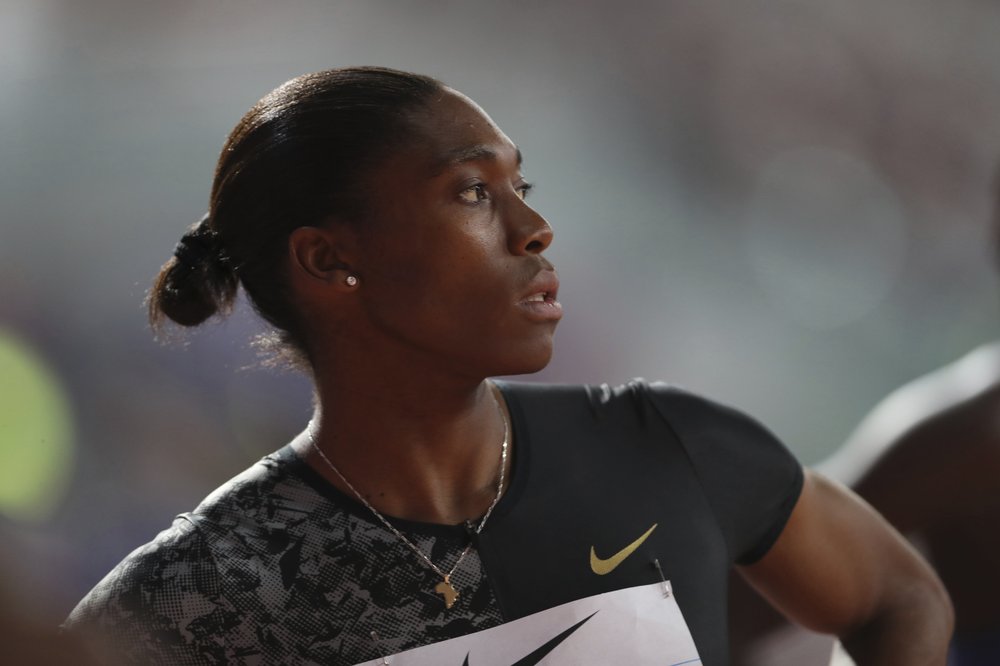Defending champion Caster Semenya sidelined at worlds

FILE – In a Friday, May 3, 2019 file photo, South Africa’s Caster Semenya competes in the women’s 800-meter final during the Diamond League in Doha, Qatar. On the 10th anniversary of Semenya blowing away the field in the 800 at the 2009 World Championships in Berlin, she won’t comply with the International Association of Athletics Federations’ latest version of a regulation to lower her level of natural testosterone.(AP Photo/Kamran Jebreili, File)
NEW YORK — Defending 800-meter champion Caster Semenya has dominated her event like no other female athlete in track over the past 10 years, winning two Olympic golds and three world championships.
A world title will be handed out Monday night without Semenya, still in her prime and still the favorite to win every race she enters.
Article continues after this advertisementThe 28-year-old South African is missing the world championships in Qatar as she fights the International Association of Athletics Federations’ latest version of a regulation that forces XY DSD women to lower their level of natural testosterone.
Even many competitors say the prestige of the race is lowered without Semenya.
Madeleine Pape of Australia competed in the 800 against Semenya at the 2009 World Championships. After an 18-year-old Semenya won the world title, the IAAF kept her sidelined for nearly a year for “gender verification” tests.
Article continues after this advertisementPape wondered about Semenya’s fast times and physique, but now realizes testosterone is not the only factor that makes a champion.
“The playing field is never level,” she said. “There will always be standout performers and athletes who struggle to be competitive. The exclusion of Semenya instead gives us an incomplete event. The IAAF is being motivated by their fears and assumptions about XY women with high testosterone.”
Semenya is joined on the sideline by 800 Olympic silver medalist Francine Niyonsaba of Burundi.
“The top two seeds before worlds aren’t here. It definitely opens things up,” said Ajee Wilson, the U.S. runner who is the strongest contender for the gold.
Wilson finished second to Semenya at the Prefontaine Classic on June 30. That’s when Semenya was temporarily allowed to race this summer. Afterward Wilson said, “everybody should be allowed to participate” and Semenya “should be able to do what she loves.”
IAAF president Sebastian Coe, recently re-elected to another four-year term, says the regulations are necessary and weren’t meant to exclude people.
“When you’re the best in the world, people become obsessed,” Semenya said recently in a video interview with The Guardian. “We’re all different.”
Of her high testosterone, Semenya says “so what?” She is joined by experts who say the IAAF hasn’t proven that what the organization considers intersex athletes have a significant advantage.
The IAAF regulations apply only to female middle-distance runners with the 46 XY Difference of Sex Development condition, requiring them to lower their testosterone below 5 nanomoles per liter of blood. They’d need to take birth control pills or hormone shots to compete in international events.
The track and field governing body has stressed the need for an “even playing field.”
However, the key research the IAAF relied upon was conducted by IAAF-aligned experts rather than independent scientists, studied female athletes with high testosterone but not intersex athletes and used data with a “huge amount” of errors, according to Roger Pielke Jr., an expert witness on scientific integrity for Semenya at the Court of Arbitration for Sport (CAS) in February.
“The IAAF has placed itself into the position of second-guessing the biology of certain women who have been female since birth,” Pielke said. “Hubris doesn’t begin to describe this attitude.”
Previously, the IAAF lost its CAS case in 2015 after Indian sprinter Dutee Chand challenged a testosterone limit below 10 nanos for all female track athletes. Those arbitrators ruled 2-1 there wasn’t enough scientific evidence that testosterone provided a significant advantage.
This spring, Semenya lost her case before CAS 2-1. The IAAF narrowed the regulation to only intersex females who compete in events ranging from the 400 meters to the mile and mandated testosterone below 5 nanos. There are no testosterone limits for men.
Arbitrators Annabelle Bennett of Australia, Hugh L. Fraser of Canada and Hans Nater of Switzerland noted the IAAF rule is discriminatory but deemed it necessary discrimination to maintain “fair competition.” Yet they had “serious concerns” about the ability of athletes to comply with the rule, given the side effects of long-term hormone use.
Semenya’s lawyers appealed and she awaits the final decision by the Swiss Federal Supreme Court. Her appeal will focus on discrimination, the ethics of forced medication and human rights.
“The rule discriminates by imposing special burdens based on characteristics — both sex and biology — that are protected from discrimination,” said Suzanne Goldberg, law professor at Columbia University and director of the Center for Gender & Sexuality Law. “Courts often look with skepticism on claims that discrimination is ‘necessary’ because those claims often amount to an effort to enshrine tradition stereotypes into law.”
The Swiss Federal Supreme Court ruled in late July that Semenya must stop running until its final decision, which could take up to a year.
Semenya recently signed with a women’s soccer team in Johannesburg, South Africa, but said on Twitter it doesn’t mean she’s no longer a track athlete.
Pielke points to a bigger problem in the sport — doping. He said the IAAF data indicates about two dozen intersex athletes among nearly 8,000 women competing at the World Championships since 2004.
Yet the “IAAF research suggests that perhaps 50 percent of athletes are doping,” he said. “It does seem that the issue of (intersex) females in sport is a tiny issue compared to the scale of doping.”
Semenya’s former competitor says the sport loses when Semenya is excluded.
“Her athletic feats and strength of character are both extraordinary and worth celebrating,” Pape said. “We make room for Caster Semenya.”